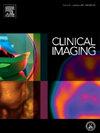加强核医学人员招聘的战略:前进的道路
IF 1.5
4区 医学
Q3 RADIOLOGY, NUCLEAR MEDICINE & MEDICAL IMAGING
引用次数: 0
摘要
自1971年获得ACGME认证以来,核医学取得了显著进步,在成像和治疗方面不断创新。尽管取得了这些技术进步,但在发展一支强大的劳动力队伍以满足日益增长的临床需求方面仍然存在挑战。有效地招聘有兴趣的、高素质的、多样化的人才是该领域持续发展的必要条件。本文回顾了招聘的障碍,并探讨了加强培训和劳动力发展的策略。后者包括更早地接触核医学和放射学,改善培训机会的公平性,并为不同阶段的受训者建立结构化的指导计划。此外,解决系统问题,例如缺乏关于培训途径的明确指导和获得高级培训机会的差异,对于扩大该领域的参与至关重要。扩大外联工作与社会主导的举措可以进一步多样化和加强招聘资源。通过巩固已经取得的进展并确定进一步发展的机会,我们的目标是激发医学学员对核医学的更大兴趣,确保该领域的持续创新和满足现代医学日益增长的临床需求的能力。本文章由计算机程序翻译,如有差异,请以英文原文为准。
Strategies to enhance recruitment in nuclear medicine: A path forward
Nuclear medicine has advanced significantly since earning ACGME accreditation in 1971, with ongoing innovations in imaging and therapy. Despite these technological strides, challenges remain in developing a robust workforce to meet the growing clinical demands. Effective recruitment of interested, well-qualified, and diverse individuals is imperative to the field's continued advancement. This article reviews barriers to recruitment and explores strategies to enhance training and workforce development. The latter includes earlier exposure to nuclear medicine and radiology, improving equity in training opportunities, and establishing structured mentorship programs for trainees at various stages. Moreover, addressing systemic issues, such as the lack of clear guidance surrounding training pathways and disparities in access to advanced training opportunities, is critical to broadening participation in the field. Expanding outreach efforts alongside society-led initiatives can further diversify and strengthen the recruitment pool. By building on the progress already made and identifying opportunities for further growth, we aim to inspire greater interest in nuclear medicine among medical trainees, ensuring the field's continued innovation and ability to meet the growing clinical demands of modern medicine.
求助全文
通过发布文献求助,成功后即可免费获取论文全文。
去求助
来源期刊

Clinical Imaging
医学-核医学
CiteScore
4.60
自引率
0.00%
发文量
265
审稿时长
35 days
期刊介绍:
The mission of Clinical Imaging is to publish, in a timely manner, the very best radiology research from the United States and around the world with special attention to the impact of medical imaging on patient care. The journal''s publications cover all imaging modalities, radiology issues related to patients, policy and practice improvements, and clinically-oriented imaging physics and informatics. The journal is a valuable resource for practicing radiologists, radiologists-in-training and other clinicians with an interest in imaging. Papers are carefully peer-reviewed and selected by our experienced subject editors who are leading experts spanning the range of imaging sub-specialties, which include:
-Body Imaging-
Breast Imaging-
Cardiothoracic Imaging-
Imaging Physics and Informatics-
Molecular Imaging and Nuclear Medicine-
Musculoskeletal and Emergency Imaging-
Neuroradiology-
Practice, Policy & Education-
Pediatric Imaging-
Vascular and Interventional Radiology
 求助内容:
求助内容: 应助结果提醒方式:
应助结果提醒方式:


